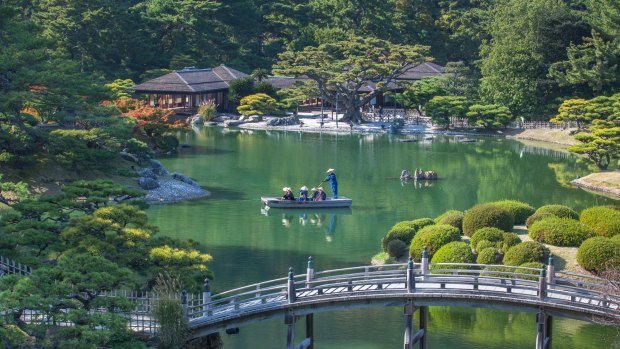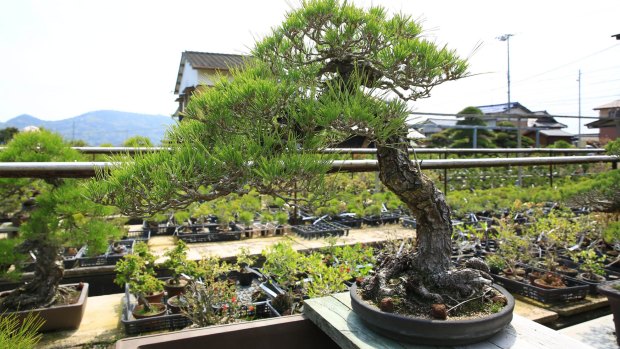This was published 6 years ago
Shikoku Island, Japan: Where to find Japan's 50 million yen bonsai trees
Kinashi Bonsai District on Japan's Shikoku Island is the place for teeny tiny trees, writes Catherine Marshall.
By Catherine Marshall

Japan's Shikoku Island is a hot-spot for bonsai and beautiful gardens. Pictured is Ritsurin Koen Garden.Credit: Alamy
The trees are shrinking to nothing on the Japanese island of Shikoku. They're being snipped and clipped and whittled and shorn until they resemble miniature versions of their former, soaring selves. This is Japan's bonsai hotspot, a mountainous island located in the Seto Inland Sea and swaddled in pine trees – the flora most beloved of bonsai artists.
Here, fourth generation bonsai gardener Teruaki Nakanishi is showing us his prized specimens, a handsome selection of miniature trees set aloft on pedestals at his nursery, Nakanishi Chinshoen, located in Shikoku's Kinashi Bonsai District. The youngest and less beautiful among them are priced at one thousand yen (about AU$12) – an affordable entre for the enthusiast who is willing to devote the hours of discipline and attention needed to nurture these fledgling bonsais into magnificence. But buyers with deep pockets will be drawn to the crème de la crème of these strictly manicured conifers: the most expensive of them sells for 50 million yen (nearly AU$600).
It's hard to believe these diminutive exemplars are about 300 years old, for though their trunks are gnarled and striped with age, their growth has been halted so they retain the stature of a sapling. The beauty in these most valuable of bonsais, apart from their age, explains Mr Nakanishi, is the pleasing shape of their trunks and their favourable rooting. The artistry of bonsai lies in the form the gardener is able to attain as he clips and coifs his little plant into obedience.
We have come to Mr Nakanishi's nursery on a shore excursion during Botanica's spring gardens cruise. It is cherry blossom season and although the cherry trees are crowned with wild pink Afros, we've turned our attention away from their magnificence to these more introverted specimens.

Nakanishi Chinshoen, a family-owned nursery in Shikoku's Kinashi Bonsai District. Credit: Catherine Marshall
This art was brought to Japan from China, says professional gardener and Botanica guide Simon Rickard, and is premised on the pursuit of age: making the young tree look old by encouraging exposed roots and a trunk that's wide at the bottom and narrow on top. The tree's outline should resemble a scalene triangle, with the base representing earth, the crown heaven and the rhythmically zigzagging trunk humankind.
"Bonsai is governed by dozens of rules and principles," Rickard explains. "The overarching rule is wabi sabi: rusticity, simplicity and the patina of age."
Mathematics directs other elements of bonsai, too: the depth of the pot should match the width of the trunk, the trunk should change direction several times, and the leaves must be defoliated to a size that's proportionate to the newly shrunken tree. Moreover, glazed pots should be used for deciduous trees – holly, crabapples, Japanese flowering apricots, cherries (which are rare in the miniature form since they don't take well to pruning) – while unglazed pots are requisite for evergreens.
It's exhausting, even before you've pulled out your miniature secateurs and pushed your spectacles onto the bridge of your nose. And it leaves me feeling somewhat tight-chested and constrained – those poor little trees, straight-jacketed into Lilliputian proportions from which they can never break free. But Rickard just laughs at this supposition.
"People liken bonsai to binding women's feet, but trees will happily grow out of a crack in a wall, or out in a field," he says.
However, unlike their relatives growing wild and free, be it in cramped spaces or expansive fields, these tiny trees are incapable of prospering alone and, without proper care, will wither and die. Having a bonsai, therefore, is like having a pet: you must care for it assiduously and when you go away, you must engage a tree minder to water and fertilise and prune and wire it. In turn, Rickard says, it will serve faithfully as a living work of art.
Catherine Marshall travelled as a guest of Botanica.
TRIP NOTES
FLY
Qantas flies to Tokyo from Sydney, Melbourne and Brisbane daily. Prices start at $850 return. See qantas.com
CRUISE
Botanica's 12-day Cherry Blossoms in Japan and South Korea Culture Cruise departs on 29 March 2018; prices start at $14,995 a person, twin share. The 14-day Japanese and South Korean Spring Gardens Cruise departs on April 7, 2018; prices start at $16,995 a person, twin share. See botanica.travel
Sign up for the Traveller Deals newsletter
Get exclusive travel deals delivered straight to your inbox. Sign up now.